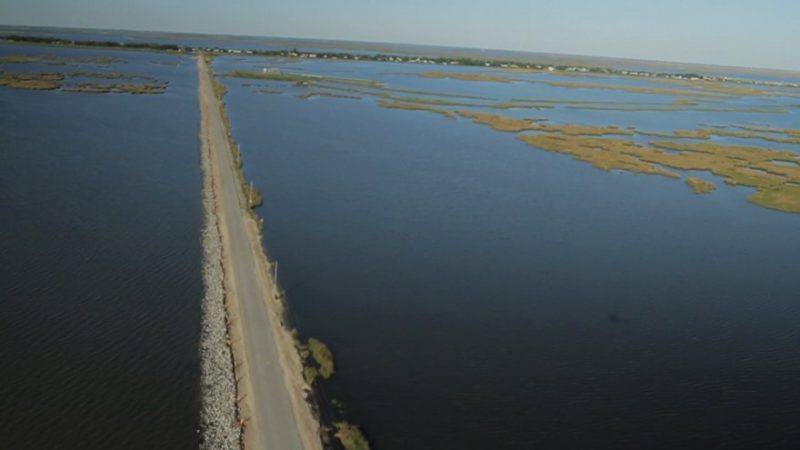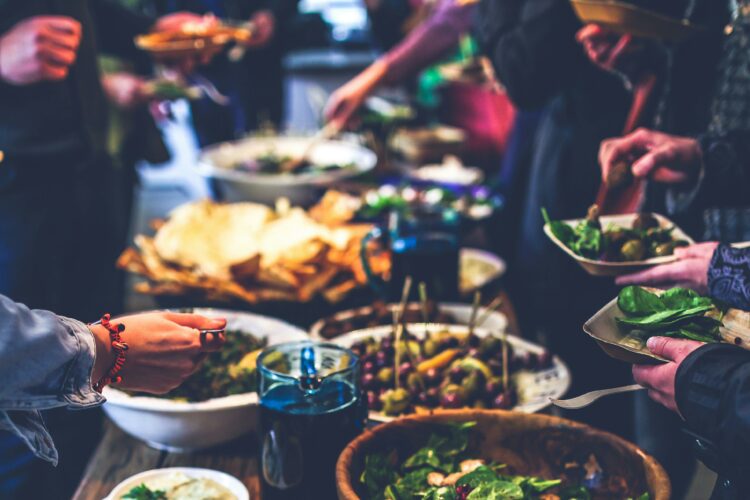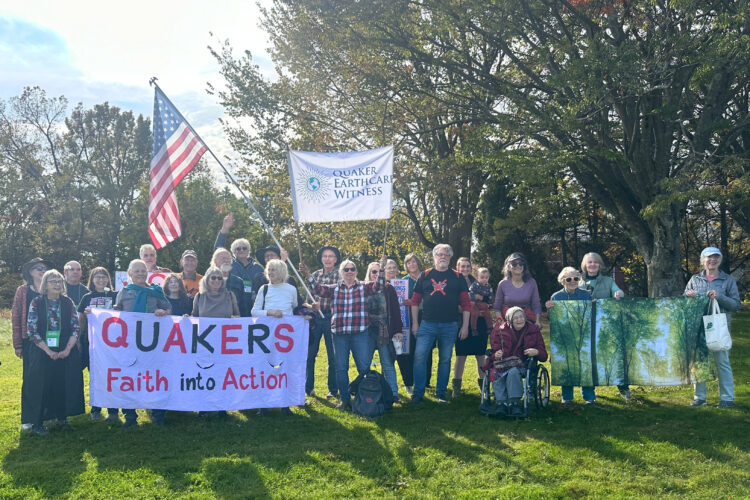Young Faith Leaders Rising During GreenFaith Convergence in New Orleans

By Sara Wolcott.
Myself and the other 60 young (aged 20-35) faith leaders from across Canada and the United States who were partaking in GreenFaith’s 2016 North American Convergence eagerly peered out of our bus windows as it turned onto the road leading to Isle de Jean Charles, Louisiana.
We had been traveling for two hours south from our base camp at Tulane University in New Orleans to reach the Isle de Jean Charles. The island is disappearing so fast that it has become the site of the first official American climate refugees; inhabitants are to receive $48 million from the federal government to support their movement off the island.
REALITY CHECK
Our leader into the bayou of Louisiana was David Gauche, the primary organizer of Bayou Interfaith Shared Community Organizing. He had been telling us stories of Louisiana’s coastal erosion, damaging oil spills, and climate-worsened hurricanes for the past several hours. He pointed out the window toward a two-mile-wide body of water and said that 15 years ago, that was a 20-foot pond. Twenty minutes down the road, he said the same thing about another body of water. We all gasped and shook our heads. None of us were new to climate change; we’d heard stories from other localities of increased storms, strange weather, droughts, and the increasing damage done by development. Still, there is nothing like having a local person tell you that a body of water that looks perfectly normal to you is not.
And the dead cypress trees surrounding us? They weren’t normal either. In Louisiana’s wetlands, cypress trees’ broad roots hold the soil together, providing the stability the ecosystem needs to survive. But they can’t take too much salt water. They were dying because the sea’s waters were increasingly encroaching upon the land. The conditions had been impacting the local people, especially fishermen, for years.
It’s one thing to watch the sea eating your livelihood; it’s another to watch it consuming your land. Or rather, to watch the consumption of a growth-based globalized economy become so strong that even the sea becomes an over-consumer, eating the land that has fed and sheltered human beings in current-day Louisiana for thousands of years (earliest settlers arrived 10,000 years ago; evidence of people cultivating squash, beans, sunflowers, and maize dates back to 100 BCE).
Our first stop on the sweltering island was near a sign that read:
We are not moving off this island. If some people want to move they can go. But leave us alone. The people have the right to live where they want, not where people tell them to go and live. They say the island is fading away. Soon we will not have the island left. If the island is not good, stay away. May God bless the Island.
It was our first tangible indication that the people on the island were bitterly divided about whether they should stay or go. Since 1955, over 90 percent of the island has faded away due to a combination of hurricanes, sea level rise, and, primarily, channels cut by loggers and oil companies that contribute to coastal erosion. The two Native American tribes on the island, most of whom were re-settled to this island a hundred years ago, do not agree on best next steps: at the moment, the official policy is voluntary leaving. A short, older man who lived across the one road that runs through the long and skinny island came to talk to us. He was born on the island: he planned to stay on it until he died.
Our next stop was to talk to the 90-something-year-old Father Roche who was born on the island and is now retired from his duties as a priest. He talked to us under his house, which he had raised on 11-foot stilts after a hurricane had flooded his home. He told us about growing up on the largely indigenous-populated island, where it took three years for the local school to get the 8th grade text book; about his own, nearly impossible journey to seminary and his life as one of the few Native American Catholic Priests in his region. We could never doubt how much he loved the land, the people, God, or Pope Francis.
Leaving him took longer than the organizers had planned: at the end of our talk, we put him in the center of our circle and laid our hands on him to bless him and the people of the island whom he serves as best he can. Afterwards, we all lined up to shake his hand, and he gave many of us, including non-Catholics like myself, a blessing on our work. For many in the group, meeting him was one of the week-long Convergence’s highlights.
And that is saying a lot, considering how many highlights the week entailed. The rest of the day included visiting local shrimp and lobster processing plants—both of which were, unusually, run by women in a male-dominated industry—and a fish-fry bake at a local restaurant, complete with cajun music, dancing, and a local alligator sighting. Sitting by the bayou, watching the alligator, I talked with Buddhists about the actual and potential value of contemplative practices for climate action; compared the heat in India versus Louisiana with some Hindus; explored the Jewishness of Jesus with Baptists and Jews; and the greatness of the Pope’s Encyclical, Laudato Si, with a Muslim.
On the night bus ride back to the beautiful campus of Tulane University, I wandered the aisle until I found some people who felt like singing. We shared some of our favorite songs from our traditions in beautiful four-part harmony, including a gathering song that has become popular in the youth-led climate justice movement. These songs became the basis for our shared final worship session which I coordinated.
SEEKERS IN HARMONY
Of the many conferences and gatherings that I have experienced as I’ve engaged with various dimensions of climate change work, especially with faith communities, over the past decade, this GreenFaith Convergence reminded me the most of the 2005 World Gathering of Young Friends in Lancaster, England. There, Young Friends from around the world’s diverse Quaker traditions gathered to meet and share fellowship across our differences. We went on field trips to various critical parts of our shared religious heritage—the walk up Pendle Hill is still a strong memory— stayed up late talking, were amply curious about one another’s diversity, sometimes disagreed, and made lasting friendships.
While GreenFaith is not the only one organizing spiritually orientated gatherings for young faith leaders involved with the ecological crises, I really enjoyed connecting with Fred Bahnson via the Regenerate Fellowship in North Carolina. The tours of various aspects of climate justice, including a policy-action protest outside of the local offices of the uber-conservative Representative Scily in New Orleans, strongly reminded me of the feeling of togetherness across differences that I felt in Lancaster, England.
Here we were, Muslim and Buddhist and Hindu and Christian and spiritual, not letting ourselves be defined by our parents and grandparents’ activism, seeking the Spirit in the midst of our planet’s crisis. This group of young people ardently believed that our planet’s peril not only should but actively does cut across all faiths. The time to lay our differences aside is now. The time to once again become people of the land and the seas is now. We do so in circles.
The week started on the full moon Summer Solstice, with a Santa Clara Pueblo woman leading a women’s Full Moon gathering. We stood in a circle at the edge of the University’s soccer field. She smudged each person with sage. She explained the importance of women, who are impacted most by climate change, of having their own circle under the moon. She then politely asked the men to leave. Without a word of protest, they picked up their bags and left us. We gathered close together, our water bottles in front of us, as she lit the candle to symbolize the sacred fire, and we told stories and prayers, made intentions, and asked Creator and one another for help. The honesty in the circle created, I believed, the foundation of honesty for the rest of the gathering. When we ended, we all—Muslim and Jewish and Catholic and Quaker—walked around the circle, just as women have done on these lands for thousands of years.
It was one of many moments when I looked around me and I thought, it is happening. Even as the waters are rising, so, too, is the Holy Spirit. Mama Earth is calling us. And those of us who listen to Jesus and to the Prophet(s) and a wide variety of guides are hearing the call. We too are rising. And we will keep moving.

